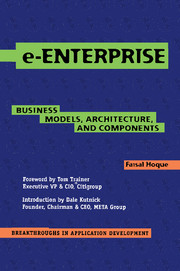Book contents
- Frontmatter
- About the Author
- Contents
- Dedication
- Foreword
- Acknowledgments
- Introduction
- PART 1 The e-Enterprise
- PART 2 Business and Application Models
- PART 3 e-Enterprise Methodology and Architecture
- PART 4 Enabling Components
- Chapter 7 e-Enterprise Business Components
- Chapter 8 e-Enterprise Technology Components
- Afterword: Who Will Be the Great e-Enterprises?
- References
- Index
Chapter 8 - e-Enterprise Technology Components
Published online by Cambridge University Press: 20 May 2010
- Frontmatter
- About the Author
- Contents
- Dedication
- Foreword
- Acknowledgments
- Introduction
- PART 1 The e-Enterprise
- PART 2 Business and Application Models
- PART 3 e-Enterprise Methodology and Architecture
- PART 4 Enabling Components
- Chapter 7 e-Enterprise Business Components
- Chapter 8 e-Enterprise Technology Components
- Afterword: Who Will Be the Great e-Enterprises?
- References
- Index
Summary
Our goal is not to be a visionary, but to get people to take advantage of what technology is available today.
—Scott McNealy, Chairman & CEO, Sun MicrosystemsWe want everybody who works on the Internet to think of Internet Explorer technologies as a platform that they can build on, a platform that they can take advantage of.
—Bill Gates, Chairman & CEO, MicrosoftIf you listen to Scott and Bill, all you have to do is to choose between Sun and Microsoft to define your e-Enterprise software infrastructure. I wish the answer was that simple. Au contraire, thanks to the IT industry, choices are unlimited and go far beyond Sun, Microsoft, and Oracle. As a matter of fact, choosing the right implementation strategy from the vast architectural and vendor options is becoming increasingly difficult.
In Chapter 6, I have outlined a high-level, logical technology architecture that contains high levels of abstractions such as e-Application Rules, e-Application Distribution/Integration, e-Data, and e-Networks. In Chapter 7, you learned the driving business components that primarily define the reusable e-Application Rules. In this final chapter, I will introduce some of the emerging technology components that should be utilized to implement these higher-level abstraction layers from a pure technology perspective.
Although this chapter discusses a few selected emerging technologies, it is not intended to be a recipe for physical implementation. Rather, it is intended to explore important standard technologies that should be understood, considered, independently verified, and validated for each e-Initiative.
- Type
- Chapter
- Information
- e-EnterpriseBusiness Models, Architecture, and Components, pp. 231 - 260Publisher: Cambridge University PressPrint publication year: 2000



